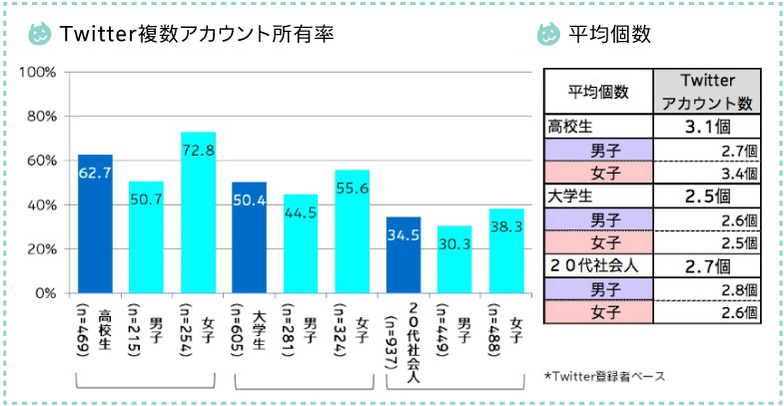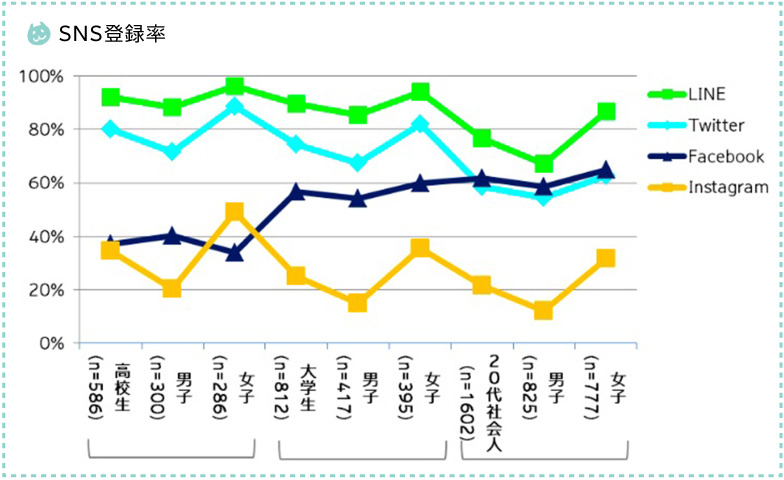In the previous Wakamon Data, we introduced findings from the "2015 Youth Understanding Survey" conducted jointly by DENTSU SOKEN INC. and Dentsu's Youth Research Department (Wakamon) in February, focusing on young people's attitudes toward the future.
They feel uncertain about Japan's future, yet they love Japan. Women in their 20s already worry about their old age.
We introduced a facet of young people's contradictory mindsets, which can be a bit hard to grasp.
*For more on the Urahara Mindset, please see this release.
This time, we'll explore young people's present circumstances using the same survey results.
It's about communication—something you can't separate from understanding young people.
Using multiple SNS platforms
With smartphones and SNS now deeply integrated as infrastructure, communication is central to the lives of today's youth. Rather than mastering just one tool or service, it's commonplace to use multiple platforms selectively.
Daily exchanges, random thoughts shared with no specific audience, photos from group trips, selfies taken at trendy cafes. They switch between multiple SNS platforms depending on who they want to see or hear them, their purpose, and the situation. Instagram is a free image-sharing app centered around photos. Its ability to showcase stylish photos has made it particularly popular among girls.
Our survey found that one in two high school girls has an account.
Recently, a photo trend called "Instagram in My Hand" became a hot topic on social media.
A futuristic and mysterious image of holding a transparent Instagram screen in your hand became popular among young people, and such trends are increasingly originating from Instagram.
Using multiple characters
When talking about this, older generations often respond with comments like, "Young people today are so busy...", "All they do is play with their smartphones...", "In our day..." (etc.). But putting that aside, if you maintain and expand multiple connections through SNS, you will always be exposed to the "gaze of others".
In fact, 72.2% of young people say they care about how others perceive them. Therefore, one communication technique is switching between different personas.

Data shows that the younger the life stage, the more active the use of different personas.
You might be the energetic leader persona in class, but among your usual crew, you're the sarcastic one.
But in reality, they're a loner character who loves watching anime alone. They switch up the "self they show" depending on the audience. You can almost hear older generations muttering, "How troublesome..." But this is a survival strategy unique to today's youth, who maintain more connections than young people did in the pre-SNS era. At its core lies the mindset that "getting along well with others is important."
Just to be clear, this doesn't mean today's youth are two-faced or untrustworthy.
Now, regarding the SNS mentioned earlier, there's also a technique for switching personas: Twitter's multiple accounts.
Using multiple Twitter accounts
For young people, "multiple accounts" – using several Twitter accounts simultaneously – is now the norm. Data shows that two out of three high school students (62.7%) and one out of two college students (50.4%) registered on Twitter have multiple accounts.
Among the most active users, female high school students, three out of four (72.8%) have multiple accounts, averaging a whopping 3.4 accounts per person.

Online terms like "main account," "sub account," and "disposable account" exist. The "main account" represents the user's real self, while sub or disposable accounts might be for hobbies or testing the waters. While this usage is commonplace, seeing it quantified makes it strikingly real.
In fact, conversations with young people are full of real-life examples like this.
Things like, "I have eight accounts!", "I have a hobby account where I can freely tweet about whatever I like without worrying," "I feel a bit hesitant to give my main account to friends I just met...", or "I have an account just for venting my frustrations, and nobody follows it or follows me back." That last one is like the emperor's new clothes, but there are also comments like, "I don't want to flood their timeline," so they'll make a collage of photos they want to post and share just one image. Even within these social media connections, there's a strong awareness of getting along with others.
Impatient high school boys expect instant replies
Finally, a little tip about using SNS.
LINE has a "read receipt" feature that shows if your message has been read. I asked people about "the time they feel is too long for a LINE message to show as read."
High schoolers, college students, and working adults in their 20s all generally want their messages seen within about 2-3 hours. But a clear difference emerged between male and female high schoolers.
Boys are more likely to think, "Check LINE faster!" They're just so impatient.
I also asked about the time they consider too long between seeing the "read" notification and getting a reply. Here, the generational difference between high schoolers, college students, and working adults in their 20s stood out.
Looking at the graph, it's clear high schoolers demand an "immediate reply" from the other person. This was just a little introduction showing how awareness of time differs by generation.
This time, focusing on youth communication, we introduced the image of young people who "switch between multiple personas" on social media. What we wanted to convey here isn't "Stop talking about personas and just be yourself!" but rather, after touching on their reality, we hope this serves as a tool to help understand them.
Rather than getting swept up in narratives like "Young people these days...", we hope this serves as a starting point to look at and listen to the reality of young people.
What kind of young people are around you?
<Survey Overview>
Overview of the "Understanding Young People Survey 2015"
・Survey Method: Online survey
・Target Areas: Kanto (1 metropolis and 6 prefectures), Kansai (2 prefectures and 4 prefectures), Tokai (3 prefectures)
・Survey Participants: Unmarried males and females aged 15-29, high school age and above
*Samples allocated based on gender/age population ratios and unmarried rates in target areas
・Sample Size: 3,000 samples
・Survey Period: February 6 (Fri) to February 9 (Mon), 2015
・Survey Implementation Agency: Dentsu Macromill Insight, Inc.

【Wakamon Profile】
Dentsu Inc. Youth Research Department (commonly known as Wakamon) is a planning team that engages with the real lives and mindsets of young people, primarily high school and university students. By understanding their "now," we seek hints to brighten and invigorate the near future. We foresee the future based on their insights and realize new businesses that foster better relationships between young people and society. Currently, 16 project members are based across our Tokyo headquarters, Kansai branch, and Chubu branch. Information is also shared on the Wakamon Facebook page.







